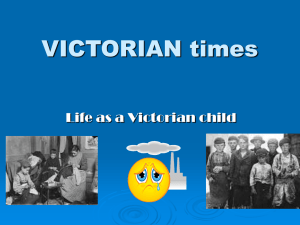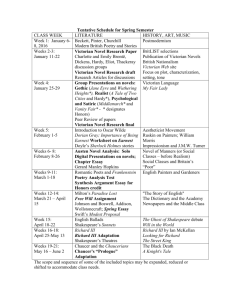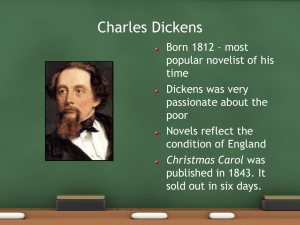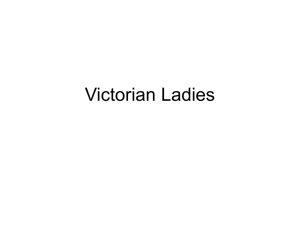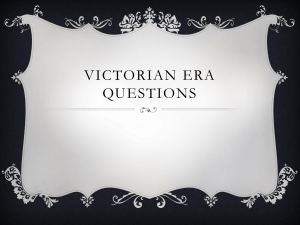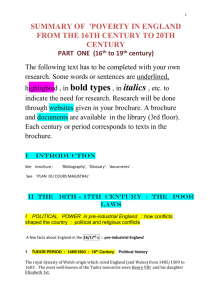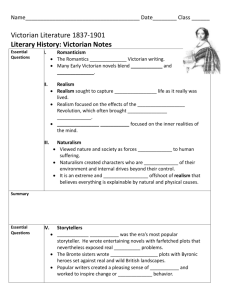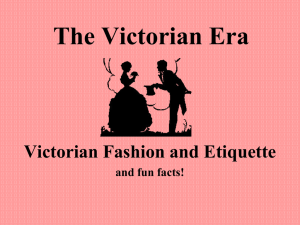iv the 19th century
advertisement
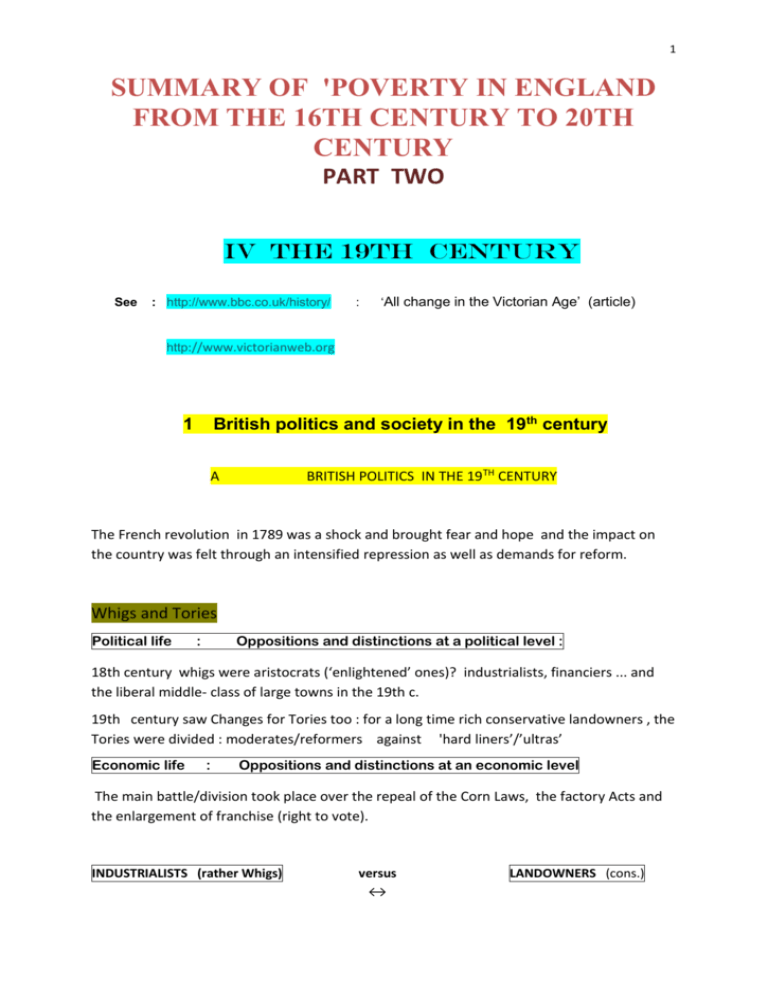
1
SUMMARY OF 'POVERTY IN ENGLAND
FROM THE 16TH CENTURY TO 20TH
CENTURY
PART TWO
IV THE 19TH CENTURY
See
: http://www.bbc.co.uk/history/
:
‘All change in the Victorian Age’ (article)
http://www.victorianweb.org
British politics and society in the 19th century
1
BRITISH POLITICS IN THE 19 TH CENTURY
A
The French revolution in 1789 was a shock and brought fear and hope and the impact on
the country was felt through an intensified repression as well as demands for reform.
Whigs and Tories
Political life
:
Oppositions and distinctions at a political level :
18th century whigs were aristocrats (‘enlightened’ ones)? industrialists, financiers ... and
the liberal middle- class of large towns in the 19th c.
19th century saw Changes for Tories too : for a long time rich conservative landowners , the
Tories were divided : moderates/reformers against 'hard liners’/’ultras’
Economic life
:
Oppositions and distinctions at an economic level
The main battle/division took place over the repeal of the Corn Laws, the factory Acts and
the enlargement of franchise (right to vote).
INDUSTRIALISTS (rather Whigs)
versus
↔
LANDOWNERS (cons.)
2
Free trade
Corn Laws
Protectionism
Throughout the 19th century, REFORMS were implemented in various fields. Radicalism
played an important role.
Radicalism and Liberalism (political radicalism and economic Liberalism) had different
purposes but sometimes their ideology overlapped.
Utilitarianism developed in the early 19th c. and
Jeremy Bentham (1749 – 1832) (see website)
B
See
was associated with the philosopher
THE VICTORIAN AGE
websites (victorianweb.org) and documents ('All change in the Victorian Age')
Website :
Three main periods :
The early Victorian age
1815 or 1830s to 1851
The mid-Victorian age
1851 to about 1875
The Late Victorian age
1875 to 1901/1914
To sum up Victorianism, it is necessary to understand what the word implied at first, and
what it meant at the beginning of the 20th century.
The early Victorian age : started in 1815
[ or 1830s ]
There was much trouble at the end of the Napoleonic wars ( see : hunger marches, the
Luddite riots (1811), the radical meeting at Peterloo (1819)...)
In the 1830s 'Victorianism 'was building up, with great expansion but also huge
discrepancies. The middle classes were slowly bringing in their values.
The mid Victorian period (1850s-1875) : Work and Wealth (with a 'Puritan
flavour')
See : Social reforms (e.g. ‘Public Health Act' in 1848) .
See : Britain as ‘the workshop of the world’
The catchwords were : Work and Wealth, Order, the Establishment.
3
1850s : by the mid 19th century, industrialisation and urbanisation had altered the lives of
women and children as much as those of men.
(see : A. De Tocqueville or G. Doré).
The late period 1870s to World War I
A period of crisis with recession, international competition, a lack of entrepreneurs and disastrous
conflicts with colonies.
The adjective 'Victorian’ in the 20th century became the opposite of the virtues it had meant at first.
The Fabian society and Socialism continued the radical struggle of the former radicals.
2.
The New Poor laws
See : Poor relief and Charity, Statistics, quotations… on brochure
1.
Sturges Bourne's Act
In 1819, in an effort to improve administration and reduce costs the Sturges Bourne Act 'To Amend
the laws for the relief of the Poor '(59 Geo. III c. 12) made changes in the way parishes were
organized. Insatisfaction was intense. Riots erupted in the 1830s .
See 'les troubles ruraux en Angleterre dans la première moitié du XIXe siècle', E. Hobsbawm, 1968,
3e étage, B.S.
2. THE New Poor Laws of the 1830s
2.1
The Poor
- the notion of Poverty/Pauperism
At the beginning of the 19th c., The notion of poverty became loaded with a new meaning, a
rather ambiguous one, and was much discussed .
Pauperism (= indigence ), the ‘idleness’ of the 18th c., became considered as a personal ,
individual flaw . It clashed with Victorian values.
There were some statistics : around 1860, 25 % of the pop is supposed to have been
undernourished (meat consumption). Horrid working conditions in industrial areas struck
people’s mind (underlined by novels), though living conditions in rural areas were even more
precarious .
G. Best (1964) in a book about working-class homes :
4
‘Early Victorian cities were extraordinarily hostile to the Poor for it was always trying to tip
them over the edge of ordinary poverty into the abyss of hopeless, helpless poverty … Every
penny was a matter of survival or sinking- until or unless you gave up the struggle to survive.
An accident, ill-health, an epidemic, a dismissal….in a family meant absolute poverty and the
workhouse. '
2.2 The Commission of 1832
PM : Charles Grey (Whig)
See The Commission Report of 1832 see brochure
It was in the face of this situation that the Whig government decided to intervene. In 1832 a
royal commission was appointed to inquire into the whole system. Two Commissioners to
remember : Nassau Senior (economist) and Edwin Chadwick (secretary), a disciple of
Jeremy Bentham.
Officials concluded that the problem was not low wages and believed outdoor relief or
allowances were harmful to the poor. The report took the view that poverty was essentially
caused by the indigence of individuals rather than economic and social conditions. The
Royal Commission made a series of 22 recommendations which were to form the basis of
the new legislation.
2.3 The New Poor Law
(PLAA = Poor Law Amendment Act)
The Poor Law Amendment Act of 1834 — An Act for the Amendment and better
Administration of the Laws relating to the Poor in England and Wales (4 & 5 Will IV c. 76)
The new Act imposed a nationwide uniformity in the treatment of paupers who applied for
relief. Outdoor relief was to be abolished eventually. It was based on the belief that the
deserving and the undeserving poor could be distinguished by a( ‘simple’) test, and 'anyone
prepared to accept relief in the workhouse must be lacking the moral determination to
survive outside it' (report).
In order to deter paupers from coming to the
were taken (see websites and documents:
workhouse
(‘The square plan) brochure
'the Workhouse':
www.workhouses.org.uk
very harsh measures
5
(see pictures of Gressenhall, Norwich), 3e étage, B.S.
The Administration of the Poor Law
The new system was put into practice by means of a large volume of orders and regulations
issued by the Commission. New administrative units called Poor Law Unions, were set up.
Each Union comprised about 6 parishes.
The poor continued to belong to their parish and then the Union.
2.4
THE ENFORCEMENT
and
Opposition to the New Act
During the first 5 years of the Act, outdoor relief was abolished and 350 new Workhouses
were built, mainly in the South of the Country.
Workhouses were criticized from the beginning .
The Poor laws misunderstood the nature of poverty, which had different causes, according
to types of work, regions, seasonal versus regular employment -north versus south....
It was fought by Local Authorities and the Commission tried to issue Orders to regulate relief :
- The Outdoor Labour Test Order , 1842, (see Gressenhall, Norwich)
- The Outdoor Relief Prohibitory Order 1844, to end all outdoor relief
The End of the Poor Law Commission
The ‘social novels’ of the 1840s (called 'the Hungry 40s') did a lot to warn the public about
the practices in the Workhouse as well as fierce hostility and organised opposition from
workers, politicians, radicals, religious leaders ( see brochure and documents + website on
social novels. In 1847 the Poor Law Commission was abolished and replaced by a new Poor
Law Board, accountable to the Parliament.
Conclusion
The workhouse was probably not as terrible as its reputation pretended. The standards
were not always bad and depended on each place. but as it aimed to enforce a
monotonous life, strict discipline, and useless tasks as well as a prison-like appearance it was
seen as unbearable .
Changes took place over the end of the 19th century (1865, 1876) and the beginning of the
20th century (the Edwardian period) but the principles of the 1834 law prevailed.
6
2.5
Victorian Philanthropy
Philanthropy (charity associations or private charity) developed considerably between 1830
and 1850, with probably twice as many volunteers as in France, for instance or elsewhere .
Charity organization movements were one of the key characteristics of Victorian era
philanthropist.
Women played an essential role in Victorian charity (see Victorian novels)
If the 18th century can be characterized by Art in the form of Landscape gardening and
Paintings, the most interesting factor characterizing the 19th century is :
THE SOCIAL NOVELS OF THE 'HUNGRY FORTIES'
The ‘social novels’ of the 1840s/1850s-60s
Affluence, leisure and education, as well as improvements in publishing turned the middle classes
into new readers, especially for novels. Interest in social problems corresponded to their
preoccupations.
In the mid-1840s a certain number of novelists focused on ‘the condition of England’ and its social
problems .
The most widely read novelist was Charles Dickens
See the story of Oliver Twist (1837) subtitled ‘Oliver Twist or the parish boy’s
progress’.
Other novels included Dombey and Son (1846) and David Copperfield (1849).
During the same period Elizabeth Gaskell in Mary Barton (1848) and North and South
(1854) (see document) examined cities and the effect of industrialization.
Others wrote about various ills : Charles Kingsley's 1848' Yeast', ( the plight of rural
labourers) , Alton Locke, (exploitation in sweatshops , slums. ..)
Benjamin Disraeli published a trilogy that focused, first, on the political and economic climate
since the 1832 Reform Bill (Coningsby, 1844); then on the evils of industrialism and dangers
of Chartism (Sybil, or the Two Nations, 1845) (see quotation on brochure); and eventually on
religion's role in ameliorating social problems ( Tancred, 1847).
7
CONCLUSION 19TH C
Despite rebellions and radical movements, writings by F. Engels and others, the working
class did not mainly join the radical movements . There was a general increase in living
standards, a desire to join the middle-class, a stability of the institutions, the power of the
empire and repression.
In a way the poor Law was a success since expenditure on the poor fell between 1835 &
1850. However the nature of poverty was never really tackled.
Toward the end of the century the hardest regulations were gradually relaxed. In 1891
supplies of toys and books were permitted in the workhouses. In 1892 tobacco and snuff
could be provided.
The Edwardian period (Edward VII, reigned 1901 – 1910 then
George V –Windsor, 1910 – 1936)
Society, after Victoria’s death was craving for change. The population increased from
16million in 1801 to 41.5 million in 1901. But 5% were unemployed an 20 % of the
population lived under the poverty threshold. The discrepancy between the rich and the
poor was greater than ever .
in 1909 David Lloyd George, the Chancellor of the Exchequer, exclaimed in introducing his
new budget: "This is a war budget for raising money to wage implacable warfare against
poverty and squalidness....it is a war against poverty, not the poor”. Finally, the National
Insurance Act of 1911, marked the birth of the Welfare State.
Nevertheless, It was not until 1930 that the poor laws were finally abolished. It was replaced
by Public Assistance laws. Outdoor relief was restored and only the aged went to the
workhouse. During the 1930s economic crisis, a Means Test was introduced to get Public
Assistance.
END OF THE 19TH CENTURY STUDY OF POVERTY
TWENTIETH CENTURY POVERTY WILL BE GIVEN ON ANOTHER PAPER
